Organisational Behaviour Analysis: 1Spatial plc Performance Report
VerifiedAdded on 2020/12/09
|15
|4720
|459
Report
AI Summary
This report examines organisational behaviour within 1Spatial plc, a software solutions provider. It explores the influence of organisational culture, politics, and power on individual and team behaviour and performance, analyzing how these elements interact and impact employee engagement. The report evaluates content and process theories of motivation, including Herzberg's Two-Factor Theory and Skinner's Reinforcement Theory, and their application in achieving organisational goals. Furthermore, it critically analyses the relationship between culture, politics, power, and motivation, and explains the characteristics of effective and ineffective teams, supported by relevant team development theories. The report concludes by applying these concepts to improve performance and foster a positive work environment within 1Spatial plc.
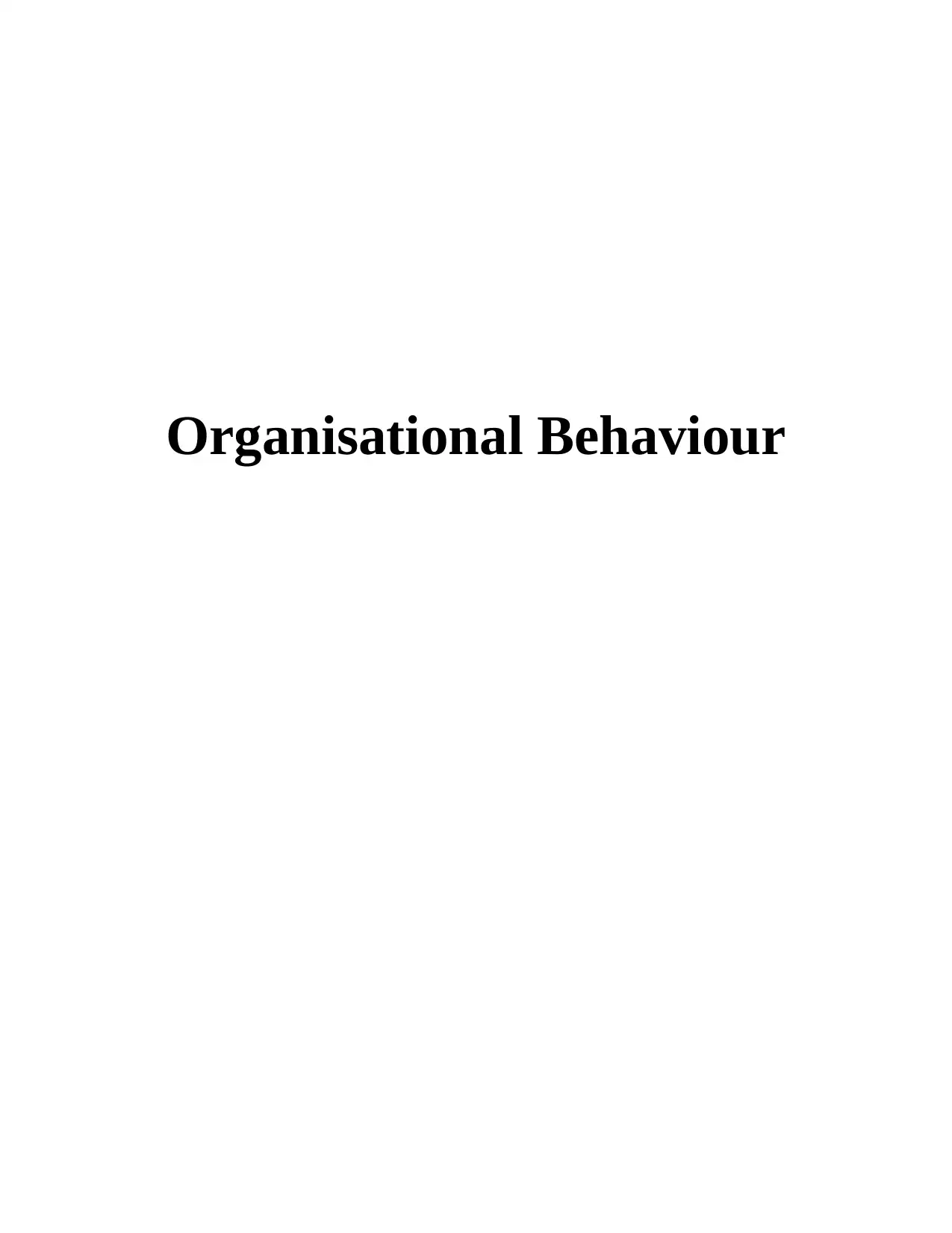
Organisational Behaviour
Paraphrase This Document
Need a fresh take? Get an instant paraphrase of this document with our AI Paraphraser
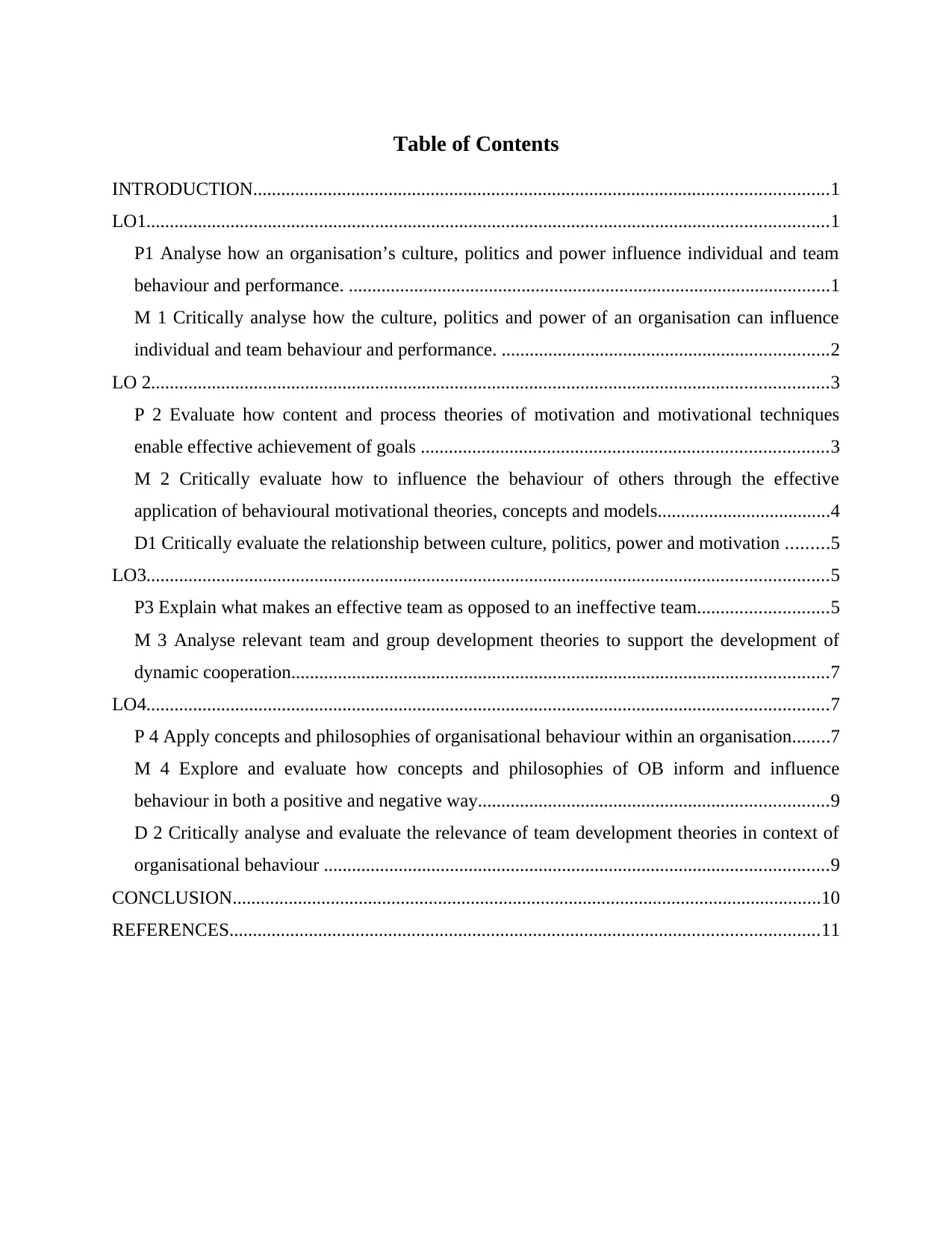
Table of Contents
INTRODUCTION...........................................................................................................................1
LO1..................................................................................................................................................1
P1 Analyse how an organisation’s culture, politics and power influence individual and team
behaviour and performance. .......................................................................................................1
M 1 Critically analyse how the culture, politics and power of an organisation can influence
individual and team behaviour and performance. ......................................................................2
LO 2.................................................................................................................................................3
P 2 Evaluate how content and process theories of motivation and motivational techniques
enable effective achievement of goals .......................................................................................3
M 2 Critically evaluate how to influence the behaviour of others through the effective
application of behavioural motivational theories, concepts and models.....................................4
D1 Critically evaluate the relationship between culture, politics, power and motivation .........5
LO3..................................................................................................................................................5
P3 Explain what makes an effective team as opposed to an ineffective team............................5
M 3 Analyse relevant team and group development theories to support the development of
dynamic cooperation...................................................................................................................7
LO4..................................................................................................................................................7
P 4 Apply concepts and philosophies of organisational behaviour within an organisation........7
M 4 Explore and evaluate how concepts and philosophies of OB inform and influence
behaviour in both a positive and negative way...........................................................................9
D 2 Critically analyse and evaluate the relevance of team development theories in context of
organisational behaviour ............................................................................................................9
CONCLUSION..............................................................................................................................10
REFERENCES..............................................................................................................................11
INTRODUCTION...........................................................................................................................1
LO1..................................................................................................................................................1
P1 Analyse how an organisation’s culture, politics and power influence individual and team
behaviour and performance. .......................................................................................................1
M 1 Critically analyse how the culture, politics and power of an organisation can influence
individual and team behaviour and performance. ......................................................................2
LO 2.................................................................................................................................................3
P 2 Evaluate how content and process theories of motivation and motivational techniques
enable effective achievement of goals .......................................................................................3
M 2 Critically evaluate how to influence the behaviour of others through the effective
application of behavioural motivational theories, concepts and models.....................................4
D1 Critically evaluate the relationship between culture, politics, power and motivation .........5
LO3..................................................................................................................................................5
P3 Explain what makes an effective team as opposed to an ineffective team............................5
M 3 Analyse relevant team and group development theories to support the development of
dynamic cooperation...................................................................................................................7
LO4..................................................................................................................................................7
P 4 Apply concepts and philosophies of organisational behaviour within an organisation........7
M 4 Explore and evaluate how concepts and philosophies of OB inform and influence
behaviour in both a positive and negative way...........................................................................9
D 2 Critically analyse and evaluate the relevance of team development theories in context of
organisational behaviour ............................................................................................................9
CONCLUSION..............................................................................................................................10
REFERENCES..............................................................................................................................11

⊘ This is a preview!⊘
Do you want full access?
Subscribe today to unlock all pages.

Trusted by 1+ million students worldwide
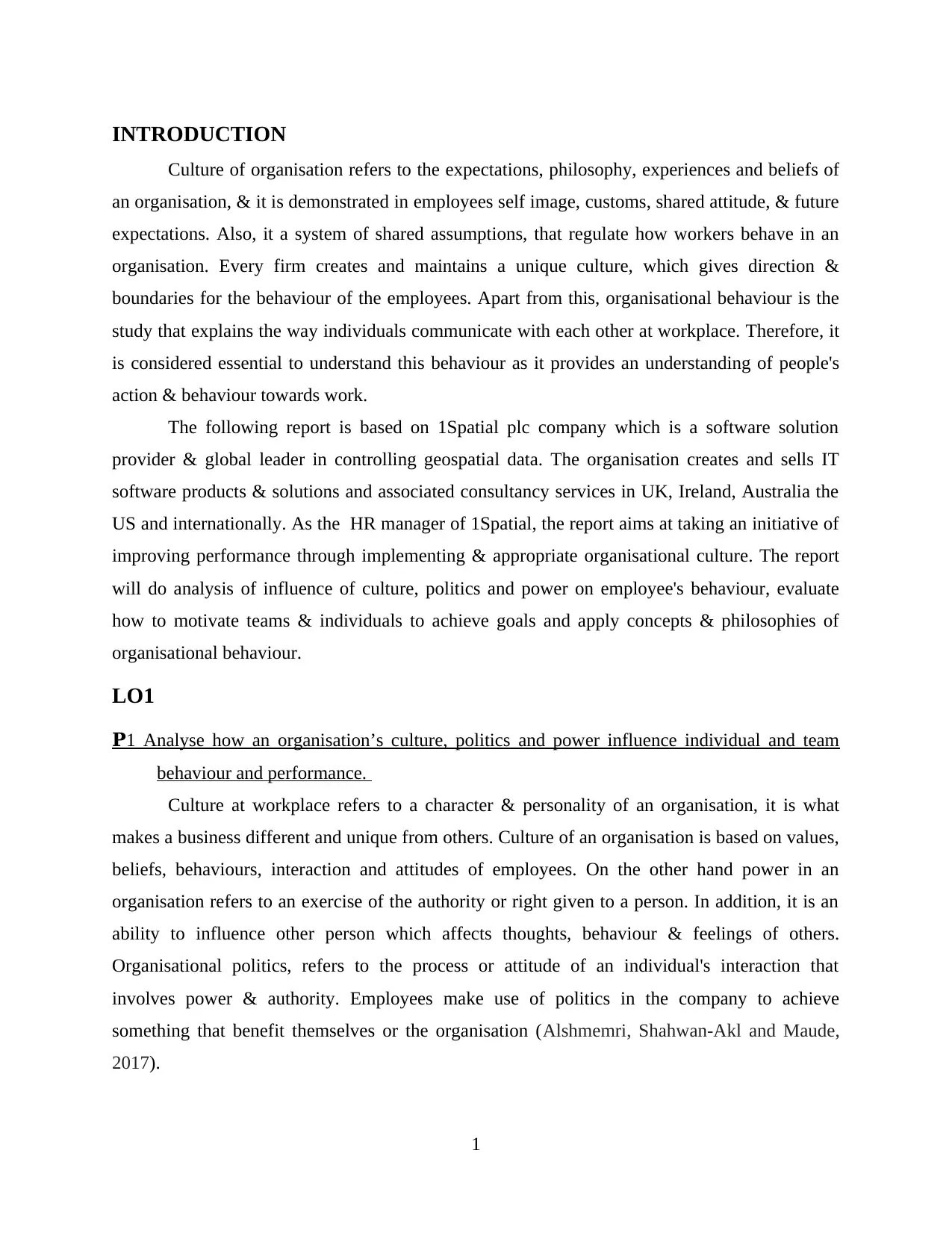
INTRODUCTION
Culture of organisation refers to the expectations, philosophy, experiences and beliefs of
an organisation, & it is demonstrated in employees self image, customs, shared attitude, & future
expectations. Also, it a system of shared assumptions, that regulate how workers behave in an
organisation. Every firm creates and maintains a unique culture, which gives direction &
boundaries for the behaviour of the employees. Apart from this, organisational behaviour is the
study that explains the way individuals communicate with each other at workplace. Therefore, it
is considered essential to understand this behaviour as it provides an understanding of people's
action & behaviour towards work.
The following report is based on 1Spatial plc company which is a software solution
provider & global leader in controlling geospatial data. The organisation creates and sells IT
software products & solutions and associated consultancy services in UK, Ireland, Australia the
US and internationally. As the HR manager of 1Spatial, the report aims at taking an initiative of
improving performance through implementing & appropriate organisational culture. The report
will do analysis of influence of culture, politics and power on employee's behaviour, evaluate
how to motivate teams & individuals to achieve goals and apply concepts & philosophies of
organisational behaviour.
LO1
P1 Analyse how an organisation’s culture, politics and power influence individual and team
behaviour and performance.
Culture at workplace refers to a character & personality of an organisation, it is what
makes a business different and unique from others. Culture of an organisation is based on values,
beliefs, behaviours, interaction and attitudes of employees. On the other hand power in an
organisation refers to an exercise of the authority or right given to a person. In addition, it is an
ability to influence other person which affects thoughts, behaviour & feelings of others.
Organisational politics, refers to the process or attitude of an individual's interaction that
involves power & authority. Employees make use of politics in the company to achieve
something that benefit themselves or the organisation (Alshmemri, Shahwan-Akl and Maude,
2017).
1
Culture of organisation refers to the expectations, philosophy, experiences and beliefs of
an organisation, & it is demonstrated in employees self image, customs, shared attitude, & future
expectations. Also, it a system of shared assumptions, that regulate how workers behave in an
organisation. Every firm creates and maintains a unique culture, which gives direction &
boundaries for the behaviour of the employees. Apart from this, organisational behaviour is the
study that explains the way individuals communicate with each other at workplace. Therefore, it
is considered essential to understand this behaviour as it provides an understanding of people's
action & behaviour towards work.
The following report is based on 1Spatial plc company which is a software solution
provider & global leader in controlling geospatial data. The organisation creates and sells IT
software products & solutions and associated consultancy services in UK, Ireland, Australia the
US and internationally. As the HR manager of 1Spatial, the report aims at taking an initiative of
improving performance through implementing & appropriate organisational culture. The report
will do analysis of influence of culture, politics and power on employee's behaviour, evaluate
how to motivate teams & individuals to achieve goals and apply concepts & philosophies of
organisational behaviour.
LO1
P1 Analyse how an organisation’s culture, politics and power influence individual and team
behaviour and performance.
Culture at workplace refers to a character & personality of an organisation, it is what
makes a business different and unique from others. Culture of an organisation is based on values,
beliefs, behaviours, interaction and attitudes of employees. On the other hand power in an
organisation refers to an exercise of the authority or right given to a person. In addition, it is an
ability to influence other person which affects thoughts, behaviour & feelings of others.
Organisational politics, refers to the process or attitude of an individual's interaction that
involves power & authority. Employees make use of politics in the company to achieve
something that benefit themselves or the organisation (Alshmemri, Shahwan-Akl and Maude,
2017).
1
Paraphrase This Document
Need a fresh take? Get an instant paraphrase of this document with our AI Paraphraser
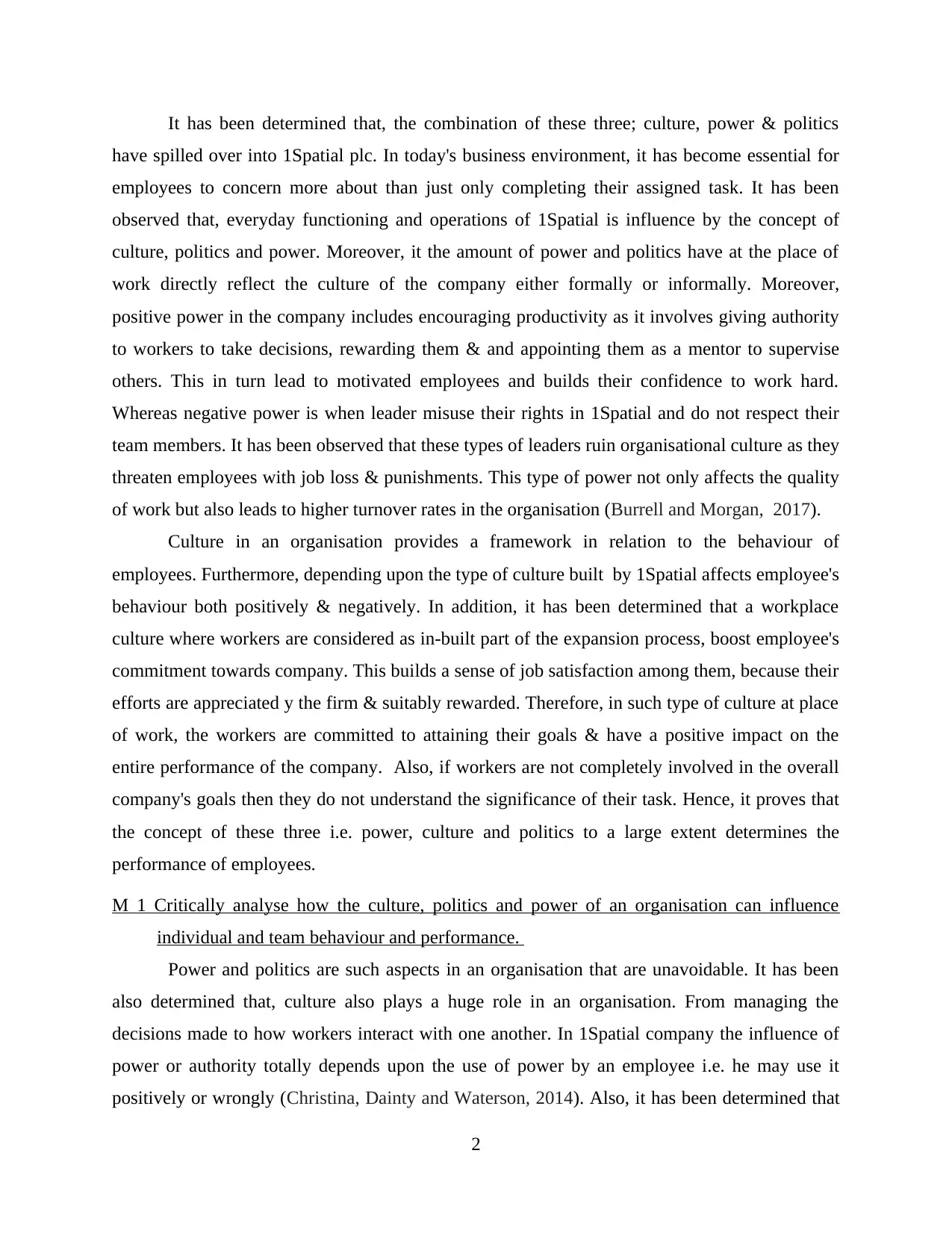
It has been determined that, the combination of these three; culture, power & politics
have spilled over into 1Spatial plc. In today's business environment, it has become essential for
employees to concern more about than just only completing their assigned task. It has been
observed that, everyday functioning and operations of 1Spatial is influence by the concept of
culture, politics and power. Moreover, it the amount of power and politics have at the place of
work directly reflect the culture of the company either formally or informally. Moreover,
positive power in the company includes encouraging productivity as it involves giving authority
to workers to take decisions, rewarding them & and appointing them as a mentor to supervise
others. This in turn lead to motivated employees and builds their confidence to work hard.
Whereas negative power is when leader misuse their rights in 1Spatial and do not respect their
team members. It has been observed that these types of leaders ruin organisational culture as they
threaten employees with job loss & punishments. This type of power not only affects the quality
of work but also leads to higher turnover rates in the organisation (Burrell and Morgan, 2017).
Culture in an organisation provides a framework in relation to the behaviour of
employees. Furthermore, depending upon the type of culture built by 1Spatial affects employee's
behaviour both positively & negatively. In addition, it has been determined that a workplace
culture where workers are considered as in-built part of the expansion process, boost employee's
commitment towards company. This builds a sense of job satisfaction among them, because their
efforts are appreciated y the firm & suitably rewarded. Therefore, in such type of culture at place
of work, the workers are committed to attaining their goals & have a positive impact on the
entire performance of the company. Also, if workers are not completely involved in the overall
company's goals then they do not understand the significance of their task. Hence, it proves that
the concept of these three i.e. power, culture and politics to a large extent determines the
performance of employees.
M 1 Critically analyse how the culture, politics and power of an organisation can influence
individual and team behaviour and performance.
Power and politics are such aspects in an organisation that are unavoidable. It has been
also determined that, culture also plays a huge role in an organisation. From managing the
decisions made to how workers interact with one another. In 1Spatial company the influence of
power or authority totally depends upon the use of power by an employee i.e. he may use it
positively or wrongly (Christina, Dainty and Waterson, 2014). Also, it has been determined that
2
have spilled over into 1Spatial plc. In today's business environment, it has become essential for
employees to concern more about than just only completing their assigned task. It has been
observed that, everyday functioning and operations of 1Spatial is influence by the concept of
culture, politics and power. Moreover, it the amount of power and politics have at the place of
work directly reflect the culture of the company either formally or informally. Moreover,
positive power in the company includes encouraging productivity as it involves giving authority
to workers to take decisions, rewarding them & and appointing them as a mentor to supervise
others. This in turn lead to motivated employees and builds their confidence to work hard.
Whereas negative power is when leader misuse their rights in 1Spatial and do not respect their
team members. It has been observed that these types of leaders ruin organisational culture as they
threaten employees with job loss & punishments. This type of power not only affects the quality
of work but also leads to higher turnover rates in the organisation (Burrell and Morgan, 2017).
Culture in an organisation provides a framework in relation to the behaviour of
employees. Furthermore, depending upon the type of culture built by 1Spatial affects employee's
behaviour both positively & negatively. In addition, it has been determined that a workplace
culture where workers are considered as in-built part of the expansion process, boost employee's
commitment towards company. This builds a sense of job satisfaction among them, because their
efforts are appreciated y the firm & suitably rewarded. Therefore, in such type of culture at place
of work, the workers are committed to attaining their goals & have a positive impact on the
entire performance of the company. Also, if workers are not completely involved in the overall
company's goals then they do not understand the significance of their task. Hence, it proves that
the concept of these three i.e. power, culture and politics to a large extent determines the
performance of employees.
M 1 Critically analyse how the culture, politics and power of an organisation can influence
individual and team behaviour and performance.
Power and politics are such aspects in an organisation that are unavoidable. It has been
also determined that, culture also plays a huge role in an organisation. From managing the
decisions made to how workers interact with one another. In 1Spatial company the influence of
power or authority totally depends upon the use of power by an employee i.e. he may use it
positively or wrongly (Christina, Dainty and Waterson, 2014). Also, it has been determined that
2
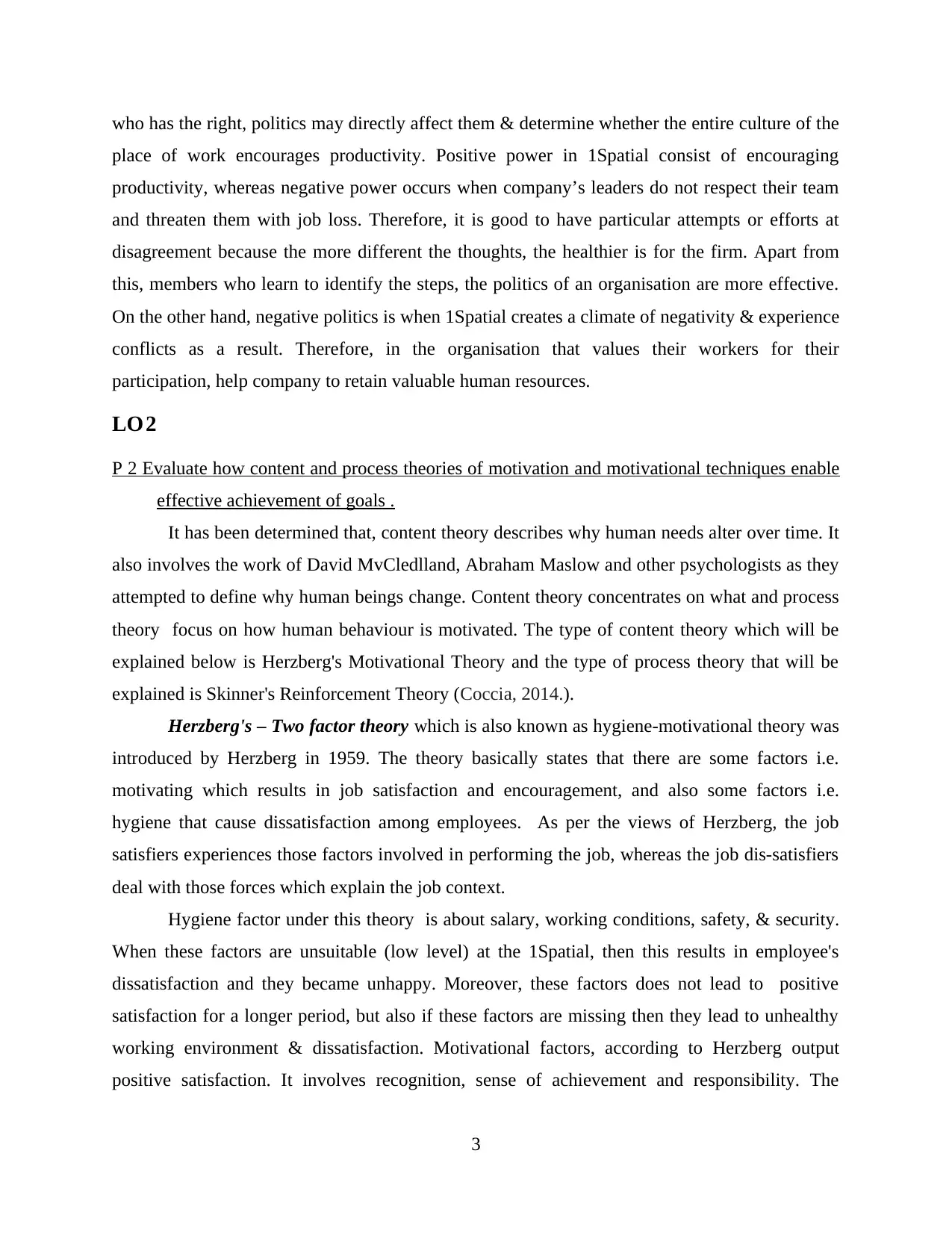
who has the right, politics may directly affect them & determine whether the entire culture of the
place of work encourages productivity. Positive power in 1Spatial consist of encouraging
productivity, whereas negative power occurs when company’s leaders do not respect their team
and threaten them with job loss. Therefore, it is good to have particular attempts or efforts at
disagreement because the more different the thoughts, the healthier is for the firm. Apart from
this, members who learn to identify the steps, the politics of an organisation are more effective.
On the other hand, negative politics is when 1Spatial creates a climate of negativity & experience
conflicts as a result. Therefore, in the organisation that values their workers for their
participation, help company to retain valuable human resources.
LO2
P 2 Evaluate how content and process theories of motivation and motivational techniques enable
effective achievement of goals .
It has been determined that, content theory describes why human needs alter over time. It
also involves the work of David MvCledlland, Abraham Maslow and other psychologists as they
attempted to define why human beings change. Content theory concentrates on what and process
theory focus on how human behaviour is motivated. The type of content theory which will be
explained below is Herzberg's Motivational Theory and the type of process theory that will be
explained is Skinner's Reinforcement Theory (Coccia, 2014.).
Herzberg's – Two factor theory which is also known as hygiene-motivational theory was
introduced by Herzberg in 1959. The theory basically states that there are some factors i.e.
motivating which results in job satisfaction and encouragement, and also some factors i.e.
hygiene that cause dissatisfaction among employees. As per the views of Herzberg, the job
satisfiers experiences those factors involved in performing the job, whereas the job dis-satisfiers
deal with those forces which explain the job context.
Hygiene factor under this theory is about salary, working conditions, safety, & security.
When these factors are unsuitable (low level) at the 1Spatial, then this results in employee's
dissatisfaction and they became unhappy. Moreover, these factors does not lead to positive
satisfaction for a longer period, but also if these factors are missing then they lead to unhealthy
working environment & dissatisfaction. Motivational factors, according to Herzberg output
positive satisfaction. It involves recognition, sense of achievement and responsibility. The
3
place of work encourages productivity. Positive power in 1Spatial consist of encouraging
productivity, whereas negative power occurs when company’s leaders do not respect their team
and threaten them with job loss. Therefore, it is good to have particular attempts or efforts at
disagreement because the more different the thoughts, the healthier is for the firm. Apart from
this, members who learn to identify the steps, the politics of an organisation are more effective.
On the other hand, negative politics is when 1Spatial creates a climate of negativity & experience
conflicts as a result. Therefore, in the organisation that values their workers for their
participation, help company to retain valuable human resources.
LO2
P 2 Evaluate how content and process theories of motivation and motivational techniques enable
effective achievement of goals .
It has been determined that, content theory describes why human needs alter over time. It
also involves the work of David MvCledlland, Abraham Maslow and other psychologists as they
attempted to define why human beings change. Content theory concentrates on what and process
theory focus on how human behaviour is motivated. The type of content theory which will be
explained below is Herzberg's Motivational Theory and the type of process theory that will be
explained is Skinner's Reinforcement Theory (Coccia, 2014.).
Herzberg's – Two factor theory which is also known as hygiene-motivational theory was
introduced by Herzberg in 1959. The theory basically states that there are some factors i.e.
motivating which results in job satisfaction and encouragement, and also some factors i.e.
hygiene that cause dissatisfaction among employees. As per the views of Herzberg, the job
satisfiers experiences those factors involved in performing the job, whereas the job dis-satisfiers
deal with those forces which explain the job context.
Hygiene factor under this theory is about salary, working conditions, safety, & security.
When these factors are unsuitable (low level) at the 1Spatial, then this results in employee's
dissatisfaction and they became unhappy. Moreover, these factors does not lead to positive
satisfaction for a longer period, but also if these factors are missing then they lead to unhealthy
working environment & dissatisfaction. Motivational factors, according to Herzberg output
positive satisfaction. It involves recognition, sense of achievement and responsibility. The
3
⊘ This is a preview!⊘
Do you want full access?
Subscribe today to unlock all pages.

Trusted by 1+ million students worldwide
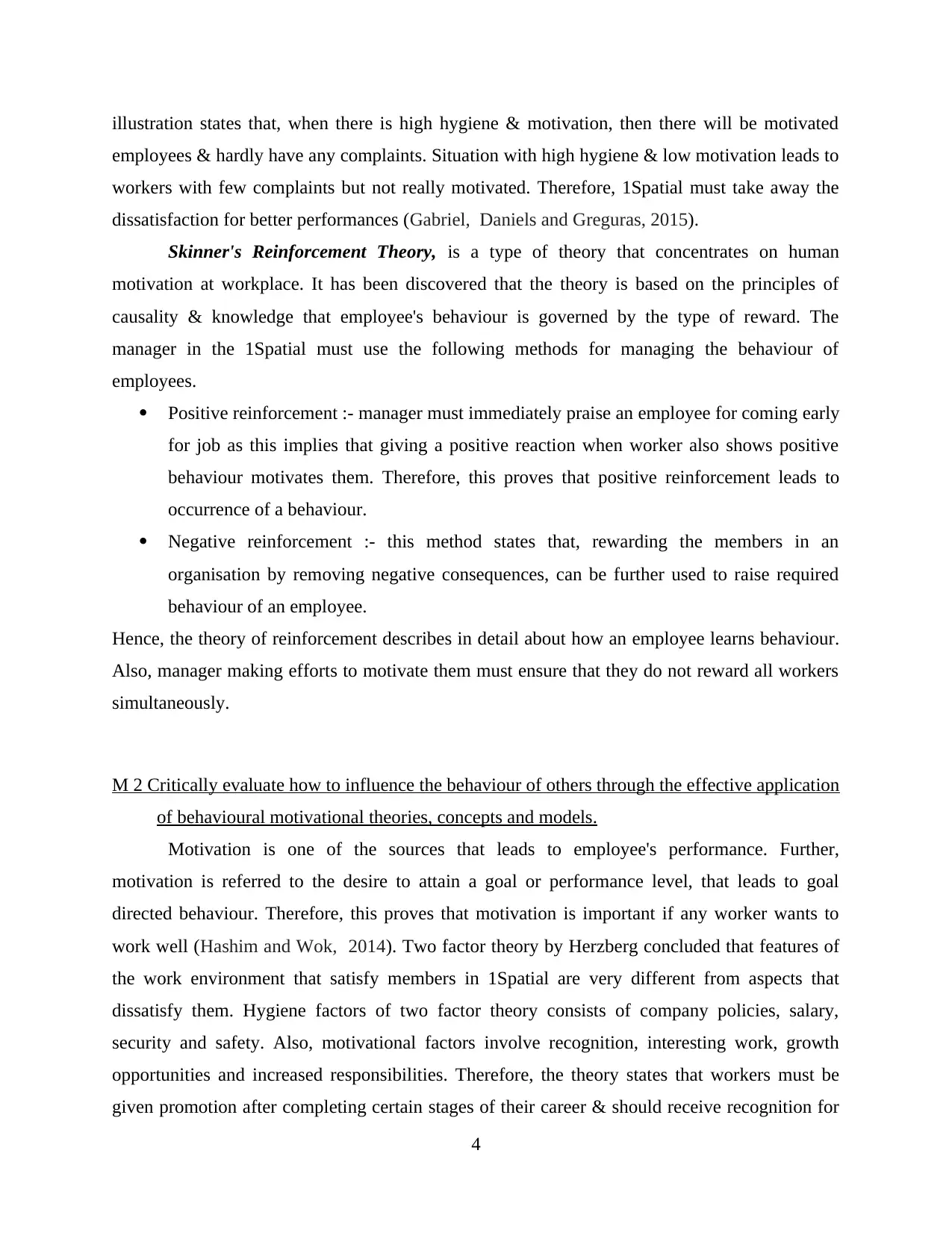
illustration states that, when there is high hygiene & motivation, then there will be motivated
employees & hardly have any complaints. Situation with high hygiene & low motivation leads to
workers with few complaints but not really motivated. Therefore, 1Spatial must take away the
dissatisfaction for better performances (Gabriel, Daniels and Greguras, 2015).
Skinner's Reinforcement Theory, is a type of theory that concentrates on human
motivation at workplace. It has been discovered that the theory is based on the principles of
causality & knowledge that employee's behaviour is governed by the type of reward. The
manager in the 1Spatial must use the following methods for managing the behaviour of
employees.
Positive reinforcement :- manager must immediately praise an employee for coming early
for job as this implies that giving a positive reaction when worker also shows positive
behaviour motivates them. Therefore, this proves that positive reinforcement leads to
occurrence of a behaviour.
Negative reinforcement :- this method states that, rewarding the members in an
organisation by removing negative consequences, can be further used to raise required
behaviour of an employee.
Hence, the theory of reinforcement describes in detail about how an employee learns behaviour.
Also, manager making efforts to motivate them must ensure that they do not reward all workers
simultaneously.
M 2 Critically evaluate how to influence the behaviour of others through the effective application
of behavioural motivational theories, concepts and models.
Motivation is one of the sources that leads to employee's performance. Further,
motivation is referred to the desire to attain a goal or performance level, that leads to goal
directed behaviour. Therefore, this proves that motivation is important if any worker wants to
work well (Hashim and Wok, 2014). Two factor theory by Herzberg concluded that features of
the work environment that satisfy members in 1Spatial are very different from aspects that
dissatisfy them. Hygiene factors of two factor theory consists of company policies, salary,
security and safety. Also, motivational factors involve recognition, interesting work, growth
opportunities and increased responsibilities. Therefore, the theory states that workers must be
given promotion after completing certain stages of their career & should receive recognition for
4
employees & hardly have any complaints. Situation with high hygiene & low motivation leads to
workers with few complaints but not really motivated. Therefore, 1Spatial must take away the
dissatisfaction for better performances (Gabriel, Daniels and Greguras, 2015).
Skinner's Reinforcement Theory, is a type of theory that concentrates on human
motivation at workplace. It has been discovered that the theory is based on the principles of
causality & knowledge that employee's behaviour is governed by the type of reward. The
manager in the 1Spatial must use the following methods for managing the behaviour of
employees.
Positive reinforcement :- manager must immediately praise an employee for coming early
for job as this implies that giving a positive reaction when worker also shows positive
behaviour motivates them. Therefore, this proves that positive reinforcement leads to
occurrence of a behaviour.
Negative reinforcement :- this method states that, rewarding the members in an
organisation by removing negative consequences, can be further used to raise required
behaviour of an employee.
Hence, the theory of reinforcement describes in detail about how an employee learns behaviour.
Also, manager making efforts to motivate them must ensure that they do not reward all workers
simultaneously.
M 2 Critically evaluate how to influence the behaviour of others through the effective application
of behavioural motivational theories, concepts and models.
Motivation is one of the sources that leads to employee's performance. Further,
motivation is referred to the desire to attain a goal or performance level, that leads to goal
directed behaviour. Therefore, this proves that motivation is important if any worker wants to
work well (Hashim and Wok, 2014). Two factor theory by Herzberg concluded that features of
the work environment that satisfy members in 1Spatial are very different from aspects that
dissatisfy them. Hygiene factors of two factor theory consists of company policies, salary,
security and safety. Also, motivational factors involve recognition, interesting work, growth
opportunities and increased responsibilities. Therefore, the theory states that workers must be
given promotion after completing certain stages of their career & should receive recognition for
4
Paraphrase This Document
Need a fresh take? Get an instant paraphrase of this document with our AI Paraphraser
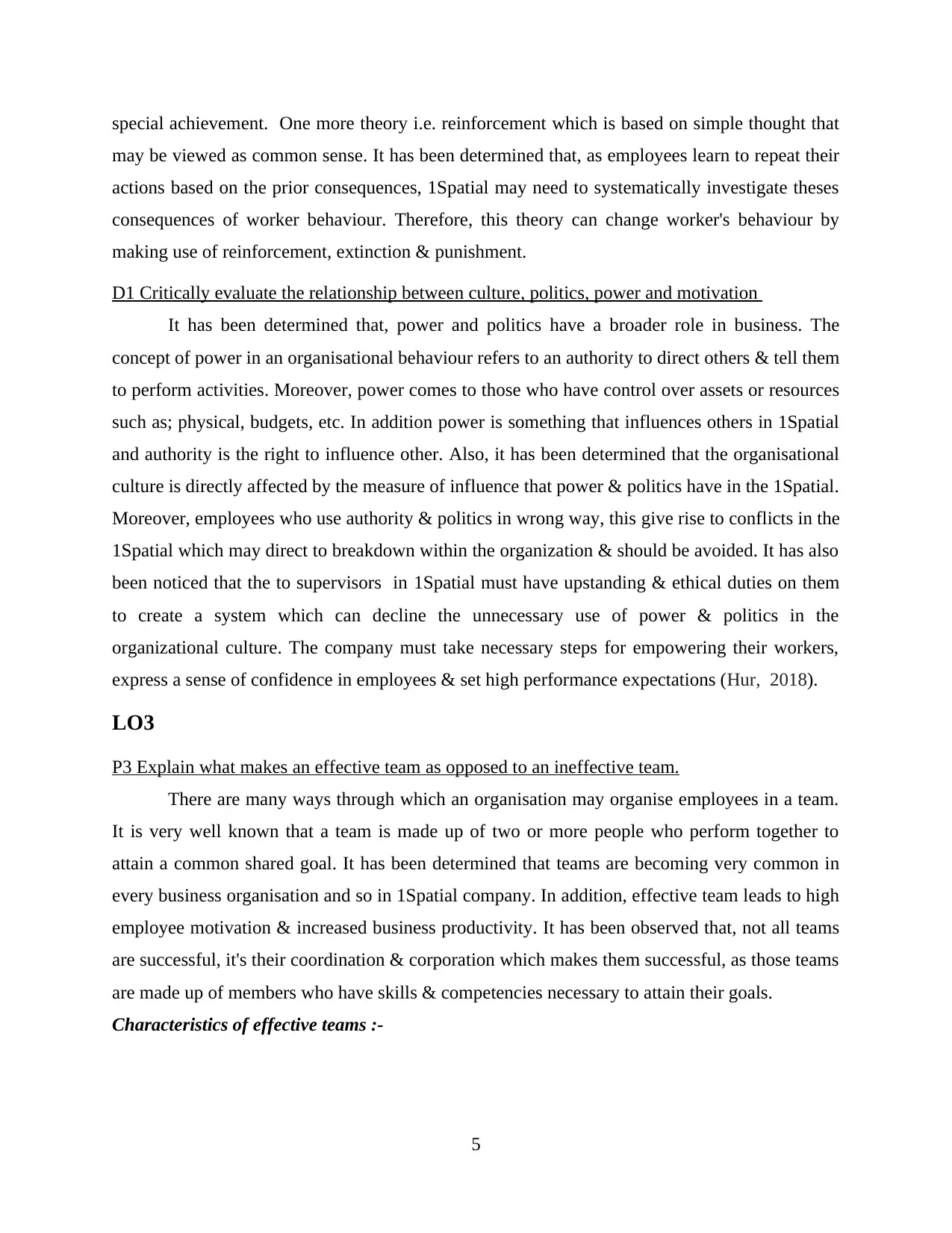
special achievement. One more theory i.e. reinforcement which is based on simple thought that
may be viewed as common sense. It has been determined that, as employees learn to repeat their
actions based on the prior consequences, 1Spatial may need to systematically investigate theses
consequences of worker behaviour. Therefore, this theory can change worker's behaviour by
making use of reinforcement, extinction & punishment.
D1 Critically evaluate the relationship between culture, politics, power and motivation
It has been determined that, power and politics have a broader role in business. The
concept of power in an organisational behaviour refers to an authority to direct others & tell them
to perform activities. Moreover, power comes to those who have control over assets or resources
such as; physical, budgets, etc. In addition power is something that influences others in 1Spatial
and authority is the right to influence other. Also, it has been determined that the organisational
culture is directly affected by the measure of influence that power & politics have in the 1Spatial.
Moreover, employees who use authority & politics in wrong way, this give rise to conflicts in the
1Spatial which may direct to breakdown within the organization & should be avoided. It has also
been noticed that the to supervisors in 1Spatial must have upstanding & ethical duties on them
to create a system which can decline the unnecessary use of power & politics in the
organizational culture. The company must take necessary steps for empowering their workers,
express a sense of confidence in employees & set high performance expectations (Hur, 2018).
LO3
P3 Explain what makes an effective team as opposed to an ineffective team.
There are many ways through which an organisation may organise employees in a team.
It is very well known that a team is made up of two or more people who perform together to
attain a common shared goal. It has been determined that teams are becoming very common in
every business organisation and so in 1Spatial company. In addition, effective team leads to high
employee motivation & increased business productivity. It has been observed that, not all teams
are successful, it's their coordination & corporation which makes them successful, as those teams
are made up of members who have skills & competencies necessary to attain their goals.
Characteristics of effective teams :-
5
may be viewed as common sense. It has been determined that, as employees learn to repeat their
actions based on the prior consequences, 1Spatial may need to systematically investigate theses
consequences of worker behaviour. Therefore, this theory can change worker's behaviour by
making use of reinforcement, extinction & punishment.
D1 Critically evaluate the relationship between culture, politics, power and motivation
It has been determined that, power and politics have a broader role in business. The
concept of power in an organisational behaviour refers to an authority to direct others & tell them
to perform activities. Moreover, power comes to those who have control over assets or resources
such as; physical, budgets, etc. In addition power is something that influences others in 1Spatial
and authority is the right to influence other. Also, it has been determined that the organisational
culture is directly affected by the measure of influence that power & politics have in the 1Spatial.
Moreover, employees who use authority & politics in wrong way, this give rise to conflicts in the
1Spatial which may direct to breakdown within the organization & should be avoided. It has also
been noticed that the to supervisors in 1Spatial must have upstanding & ethical duties on them
to create a system which can decline the unnecessary use of power & politics in the
organizational culture. The company must take necessary steps for empowering their workers,
express a sense of confidence in employees & set high performance expectations (Hur, 2018).
LO3
P3 Explain what makes an effective team as opposed to an ineffective team.
There are many ways through which an organisation may organise employees in a team.
It is very well known that a team is made up of two or more people who perform together to
attain a common shared goal. It has been determined that teams are becoming very common in
every business organisation and so in 1Spatial company. In addition, effective team leads to high
employee motivation & increased business productivity. It has been observed that, not all teams
are successful, it's their coordination & corporation which makes them successful, as those teams
are made up of members who have skills & competencies necessary to attain their goals.
Characteristics of effective teams :-
5
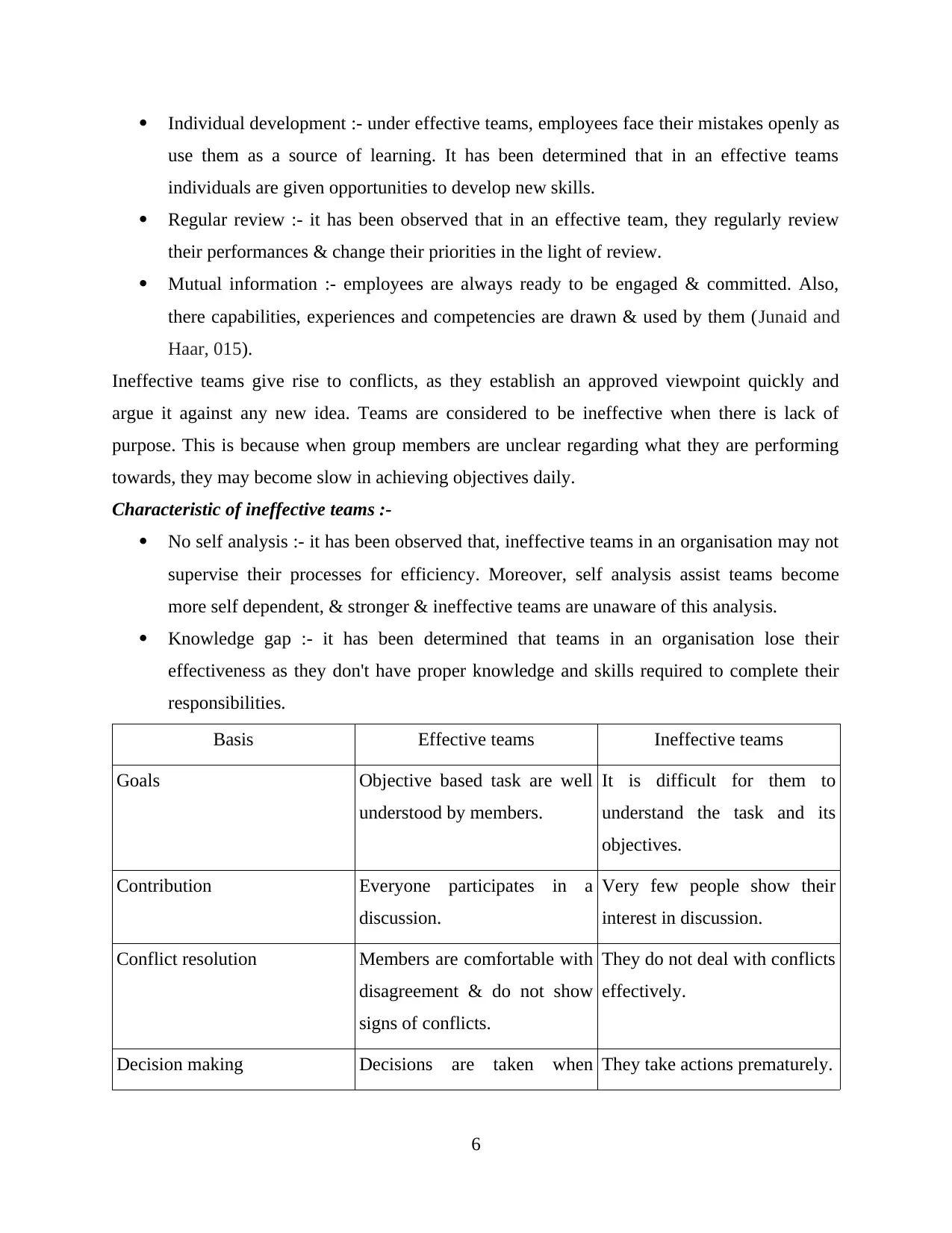
Individual development :- under effective teams, employees face their mistakes openly as
use them as a source of learning. It has been determined that in an effective teams
individuals are given opportunities to develop new skills.
Regular review :- it has been observed that in an effective team, they regularly review
their performances & change their priorities in the light of review.
Mutual information :- employees are always ready to be engaged & committed. Also,
there capabilities, experiences and competencies are drawn & used by them (Junaid and
Haar, 015).
Ineffective teams give rise to conflicts, as they establish an approved viewpoint quickly and
argue it against any new idea. Teams are considered to be ineffective when there is lack of
purpose. This is because when group members are unclear regarding what they are performing
towards, they may become slow in achieving objectives daily.
Characteristic of ineffective teams :-
No self analysis :- it has been observed that, ineffective teams in an organisation may not
supervise their processes for efficiency. Moreover, self analysis assist teams become
more self dependent, & stronger & ineffective teams are unaware of this analysis.
Knowledge gap :- it has been determined that teams in an organisation lose their
effectiveness as they don't have proper knowledge and skills required to complete their
responsibilities.
Basis Effective teams Ineffective teams
Goals Objective based task are well
understood by members.
It is difficult for them to
understand the task and its
objectives.
Contribution Everyone participates in a
discussion.
Very few people show their
interest in discussion.
Conflict resolution Members are comfortable with
disagreement & do not show
signs of conflicts.
They do not deal with conflicts
effectively.
Decision making Decisions are taken when They take actions prematurely.
6
use them as a source of learning. It has been determined that in an effective teams
individuals are given opportunities to develop new skills.
Regular review :- it has been observed that in an effective team, they regularly review
their performances & change their priorities in the light of review.
Mutual information :- employees are always ready to be engaged & committed. Also,
there capabilities, experiences and competencies are drawn & used by them (Junaid and
Haar, 015).
Ineffective teams give rise to conflicts, as they establish an approved viewpoint quickly and
argue it against any new idea. Teams are considered to be ineffective when there is lack of
purpose. This is because when group members are unclear regarding what they are performing
towards, they may become slow in achieving objectives daily.
Characteristic of ineffective teams :-
No self analysis :- it has been observed that, ineffective teams in an organisation may not
supervise their processes for efficiency. Moreover, self analysis assist teams become
more self dependent, & stronger & ineffective teams are unaware of this analysis.
Knowledge gap :- it has been determined that teams in an organisation lose their
effectiveness as they don't have proper knowledge and skills required to complete their
responsibilities.
Basis Effective teams Ineffective teams
Goals Objective based task are well
understood by members.
It is difficult for them to
understand the task and its
objectives.
Contribution Everyone participates in a
discussion.
Very few people show their
interest in discussion.
Conflict resolution Members are comfortable with
disagreement & do not show
signs of conflicts.
They do not deal with conflicts
effectively.
Decision making Decisions are taken when They take actions prematurely.
6
⊘ This is a preview!⊘
Do you want full access?
Subscribe today to unlock all pages.

Trusted by 1+ million students worldwide
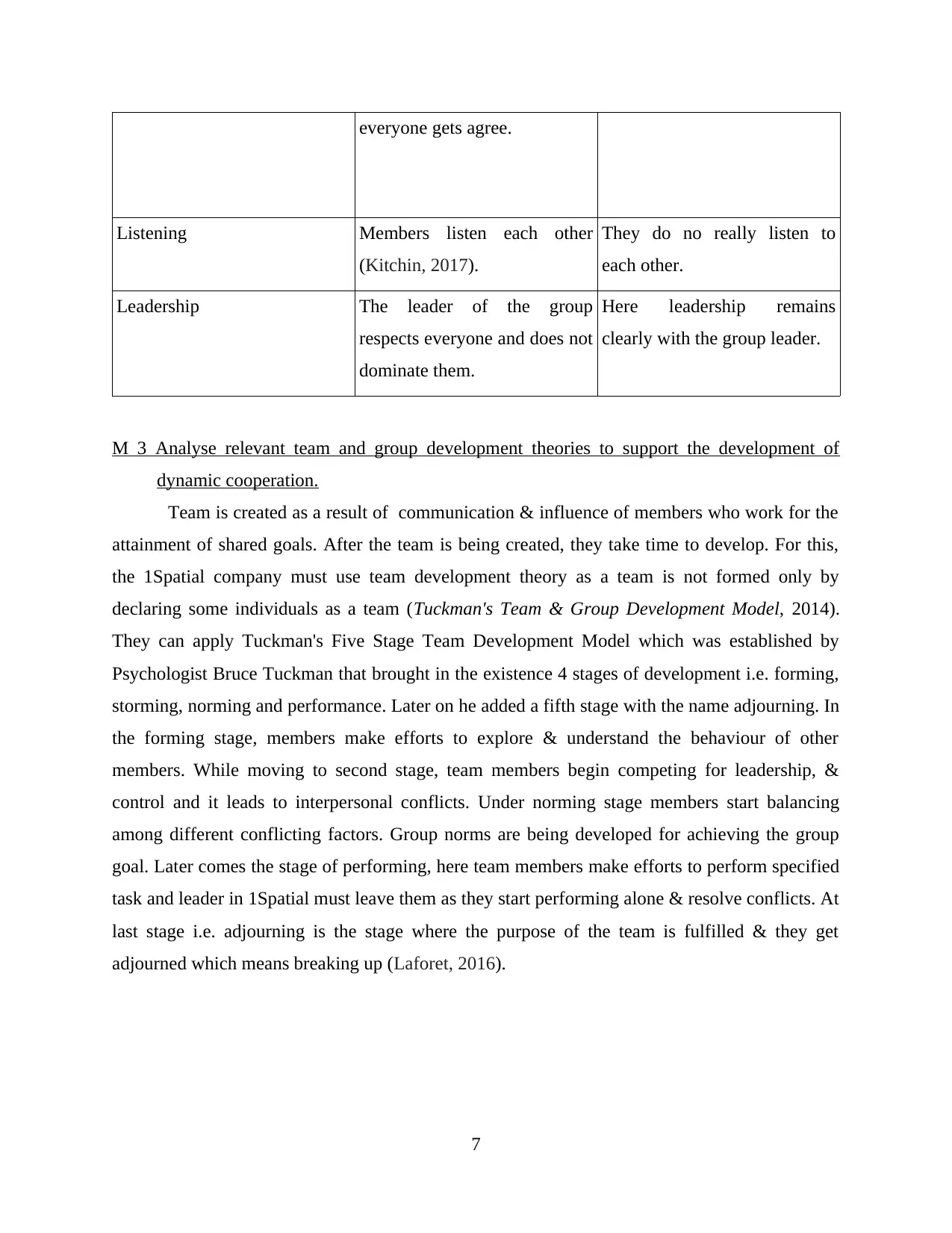
everyone gets agree.
Listening Members listen each other
(Kitchin, 2017).
They do no really listen to
each other.
Leadership The leader of the group
respects everyone and does not
dominate them.
Here leadership remains
clearly with the group leader.
M 3 Analyse relevant team and group development theories to support the development of
dynamic cooperation.
Team is created as a result of communication & influence of members who work for the
attainment of shared goals. After the team is being created, they take time to develop. For this,
the 1Spatial company must use team development theory as a team is not formed only by
declaring some individuals as a team (Tuckman's Team & Group Development Model, 2014).
They can apply Tuckman's Five Stage Team Development Model which was established by
Psychologist Bruce Tuckman that brought in the existence 4 stages of development i.e. forming,
storming, norming and performance. Later on he added a fifth stage with the name adjourning. In
the forming stage, members make efforts to explore & understand the behaviour of other
members. While moving to second stage, team members begin competing for leadership, &
control and it leads to interpersonal conflicts. Under norming stage members start balancing
among different conflicting factors. Group norms are being developed for achieving the group
goal. Later comes the stage of performing, here team members make efforts to perform specified
task and leader in 1Spatial must leave them as they start performing alone & resolve conflicts. At
last stage i.e. adjourning is the stage where the purpose of the team is fulfilled & they get
adjourned which means breaking up (Laforet, 2016).
7
Listening Members listen each other
(Kitchin, 2017).
They do no really listen to
each other.
Leadership The leader of the group
respects everyone and does not
dominate them.
Here leadership remains
clearly with the group leader.
M 3 Analyse relevant team and group development theories to support the development of
dynamic cooperation.
Team is created as a result of communication & influence of members who work for the
attainment of shared goals. After the team is being created, they take time to develop. For this,
the 1Spatial company must use team development theory as a team is not formed only by
declaring some individuals as a team (Tuckman's Team & Group Development Model, 2014).
They can apply Tuckman's Five Stage Team Development Model which was established by
Psychologist Bruce Tuckman that brought in the existence 4 stages of development i.e. forming,
storming, norming and performance. Later on he added a fifth stage with the name adjourning. In
the forming stage, members make efforts to explore & understand the behaviour of other
members. While moving to second stage, team members begin competing for leadership, &
control and it leads to interpersonal conflicts. Under norming stage members start balancing
among different conflicting factors. Group norms are being developed for achieving the group
goal. Later comes the stage of performing, here team members make efforts to perform specified
task and leader in 1Spatial must leave them as they start performing alone & resolve conflicts. At
last stage i.e. adjourning is the stage where the purpose of the team is fulfilled & they get
adjourned which means breaking up (Laforet, 2016).
7
Paraphrase This Document
Need a fresh take? Get an instant paraphrase of this document with our AI Paraphraser
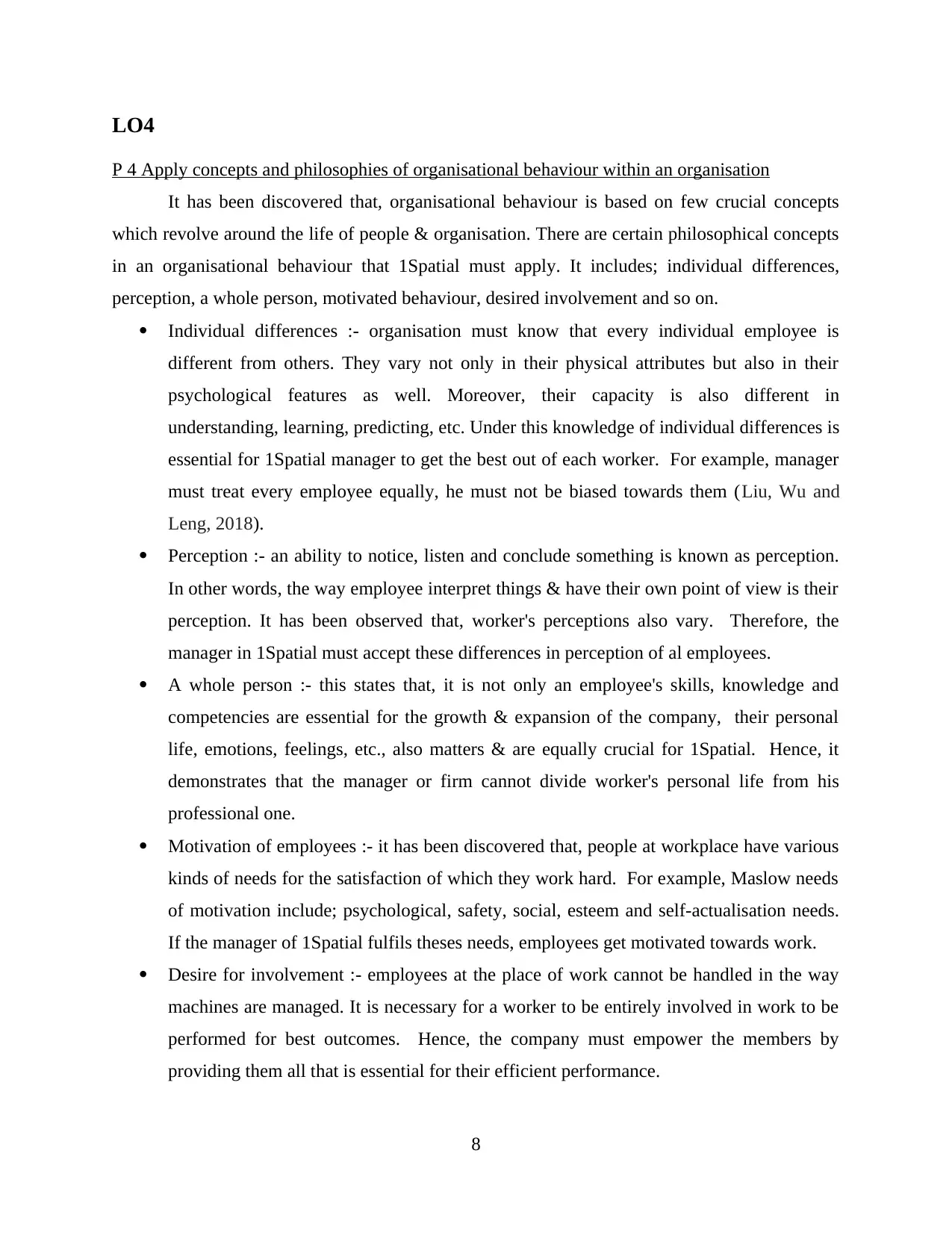
LO4
P 4 Apply concepts and philosophies of organisational behaviour within an organisation
It has been discovered that, organisational behaviour is based on few crucial concepts
which revolve around the life of people & organisation. There are certain philosophical concepts
in an organisational behaviour that 1Spatial must apply. It includes; individual differences,
perception, a whole person, motivated behaviour, desired involvement and so on.
Individual differences :- organisation must know that every individual employee is
different from others. They vary not only in their physical attributes but also in their
psychological features as well. Moreover, their capacity is also different in
understanding, learning, predicting, etc. Under this knowledge of individual differences is
essential for 1Spatial manager to get the best out of each worker. For example, manager
must treat every employee equally, he must not be biased towards them (Liu, Wu and
Leng, 2018).
Perception :- an ability to notice, listen and conclude something is known as perception.
In other words, the way employee interpret things & have their own point of view is their
perception. It has been observed that, worker's perceptions also vary. Therefore, the
manager in 1Spatial must accept these differences in perception of al employees.
A whole person :- this states that, it is not only an employee's skills, knowledge and
competencies are essential for the growth & expansion of the company, their personal
life, emotions, feelings, etc., also matters & are equally crucial for 1Spatial. Hence, it
demonstrates that the manager or firm cannot divide worker's personal life from his
professional one.
Motivation of employees :- it has been discovered that, people at workplace have various
kinds of needs for the satisfaction of which they work hard. For example, Maslow needs
of motivation include; psychological, safety, social, esteem and self-actualisation needs.
If the manager of 1Spatial fulfils theses needs, employees get motivated towards work.
Desire for involvement :- employees at the place of work cannot be handled in the way
machines are managed. It is necessary for a worker to be entirely involved in work to be
performed for best outcomes. Hence, the company must empower the members by
providing them all that is essential for their efficient performance.
8
P 4 Apply concepts and philosophies of organisational behaviour within an organisation
It has been discovered that, organisational behaviour is based on few crucial concepts
which revolve around the life of people & organisation. There are certain philosophical concepts
in an organisational behaviour that 1Spatial must apply. It includes; individual differences,
perception, a whole person, motivated behaviour, desired involvement and so on.
Individual differences :- organisation must know that every individual employee is
different from others. They vary not only in their physical attributes but also in their
psychological features as well. Moreover, their capacity is also different in
understanding, learning, predicting, etc. Under this knowledge of individual differences is
essential for 1Spatial manager to get the best out of each worker. For example, manager
must treat every employee equally, he must not be biased towards them (Liu, Wu and
Leng, 2018).
Perception :- an ability to notice, listen and conclude something is known as perception.
In other words, the way employee interpret things & have their own point of view is their
perception. It has been observed that, worker's perceptions also vary. Therefore, the
manager in 1Spatial must accept these differences in perception of al employees.
A whole person :- this states that, it is not only an employee's skills, knowledge and
competencies are essential for the growth & expansion of the company, their personal
life, emotions, feelings, etc., also matters & are equally crucial for 1Spatial. Hence, it
demonstrates that the manager or firm cannot divide worker's personal life from his
professional one.
Motivation of employees :- it has been discovered that, people at workplace have various
kinds of needs for the satisfaction of which they work hard. For example, Maslow needs
of motivation include; psychological, safety, social, esteem and self-actualisation needs.
If the manager of 1Spatial fulfils theses needs, employees get motivated towards work.
Desire for involvement :- employees at the place of work cannot be handled in the way
machines are managed. It is necessary for a worker to be entirely involved in work to be
performed for best outcomes. Hence, the company must empower the members by
providing them all that is essential for their efficient performance.
8
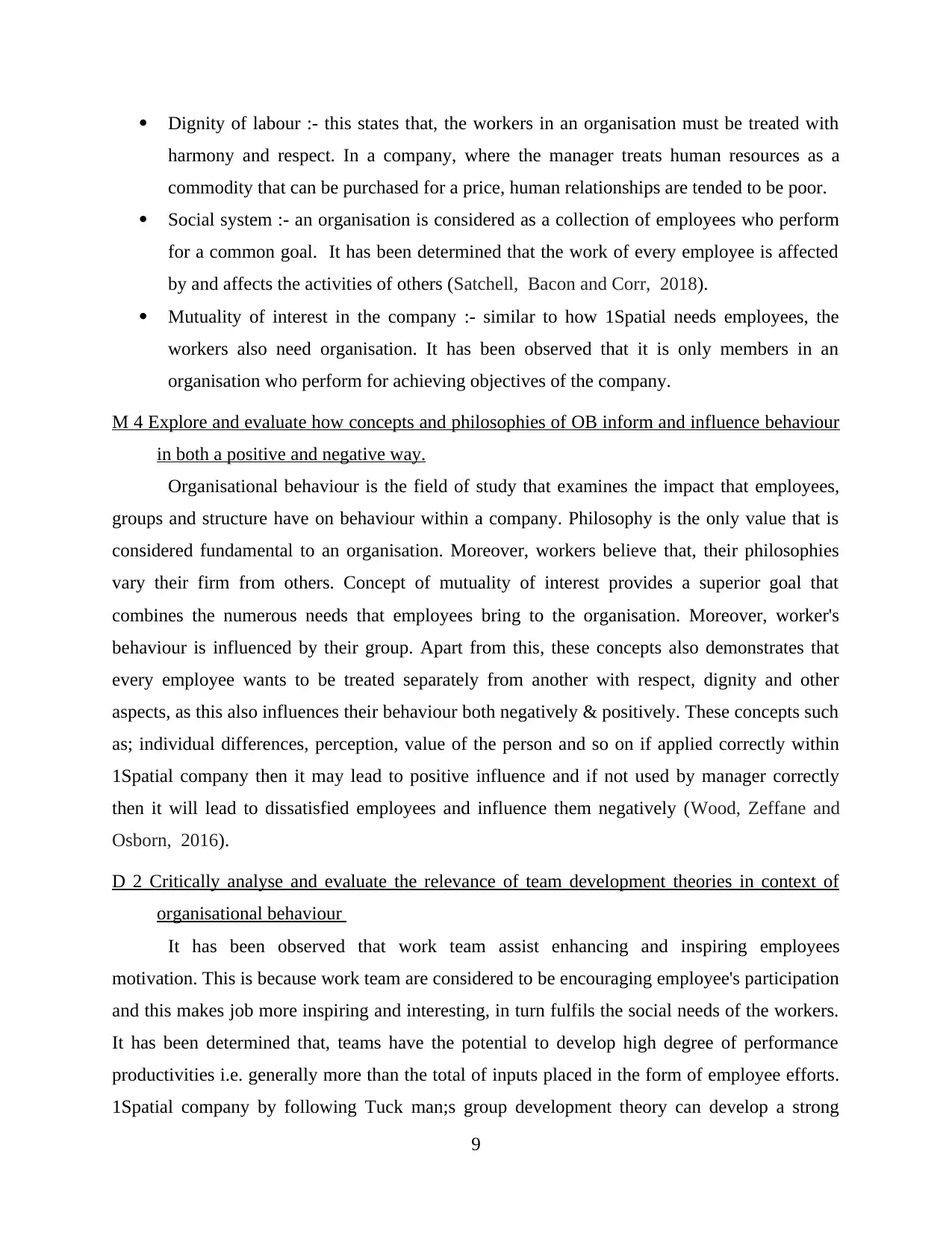
Dignity of labour :- this states that, the workers in an organisation must be treated with
harmony and respect. In a company, where the manager treats human resources as a
commodity that can be purchased for a price, human relationships are tended to be poor.
Social system :- an organisation is considered as a collection of employees who perform
for a common goal. It has been determined that the work of every employee is affected
by and affects the activities of others (Satchell, Bacon and Corr, 2018).
Mutuality of interest in the company :- similar to how 1Spatial needs employees, the
workers also need organisation. It has been observed that it is only members in an
organisation who perform for achieving objectives of the company.
M 4 Explore and evaluate how concepts and philosophies of OB inform and influence behaviour
in both a positive and negative way.
Organisational behaviour is the field of study that examines the impact that employees,
groups and structure have on behaviour within a company. Philosophy is the only value that is
considered fundamental to an organisation. Moreover, workers believe that, their philosophies
vary their firm from others. Concept of mutuality of interest provides a superior goal that
combines the numerous needs that employees bring to the organisation. Moreover, worker's
behaviour is influenced by their group. Apart from this, these concepts also demonstrates that
every employee wants to be treated separately from another with respect, dignity and other
aspects, as this also influences their behaviour both negatively & positively. These concepts such
as; individual differences, perception, value of the person and so on if applied correctly within
1Spatial company then it may lead to positive influence and if not used by manager correctly
then it will lead to dissatisfied employees and influence them negatively (Wood, Zeffane and
Osborn, 2016).
D 2 Critically analyse and evaluate the relevance of team development theories in context of
organisational behaviour
It has been observed that work team assist enhancing and inspiring employees
motivation. This is because work team are considered to be encouraging employee's participation
and this makes job more inspiring and interesting, in turn fulfils the social needs of the workers.
It has been determined that, teams have the potential to develop high degree of performance
productivities i.e. generally more than the total of inputs placed in the form of employee efforts.
1Spatial company by following Tuck man;s group development theory can develop a strong
9
harmony and respect. In a company, where the manager treats human resources as a
commodity that can be purchased for a price, human relationships are tended to be poor.
Social system :- an organisation is considered as a collection of employees who perform
for a common goal. It has been determined that the work of every employee is affected
by and affects the activities of others (Satchell, Bacon and Corr, 2018).
Mutuality of interest in the company :- similar to how 1Spatial needs employees, the
workers also need organisation. It has been observed that it is only members in an
organisation who perform for achieving objectives of the company.
M 4 Explore and evaluate how concepts and philosophies of OB inform and influence behaviour
in both a positive and negative way.
Organisational behaviour is the field of study that examines the impact that employees,
groups and structure have on behaviour within a company. Philosophy is the only value that is
considered fundamental to an organisation. Moreover, workers believe that, their philosophies
vary their firm from others. Concept of mutuality of interest provides a superior goal that
combines the numerous needs that employees bring to the organisation. Moreover, worker's
behaviour is influenced by their group. Apart from this, these concepts also demonstrates that
every employee wants to be treated separately from another with respect, dignity and other
aspects, as this also influences their behaviour both negatively & positively. These concepts such
as; individual differences, perception, value of the person and so on if applied correctly within
1Spatial company then it may lead to positive influence and if not used by manager correctly
then it will lead to dissatisfied employees and influence them negatively (Wood, Zeffane and
Osborn, 2016).
D 2 Critically analyse and evaluate the relevance of team development theories in context of
organisational behaviour
It has been observed that work team assist enhancing and inspiring employees
motivation. This is because work team are considered to be encouraging employee's participation
and this makes job more inspiring and interesting, in turn fulfils the social needs of the workers.
It has been determined that, teams have the potential to develop high degree of performance
productivities i.e. generally more than the total of inputs placed in the form of employee efforts.
1Spatial company by following Tuck man;s group development theory can develop a strong
9
⊘ This is a preview!⊘
Do you want full access?
Subscribe today to unlock all pages.

Trusted by 1+ million students worldwide
1 out of 15
Related Documents
Your All-in-One AI-Powered Toolkit for Academic Success.
+13062052269
info@desklib.com
Available 24*7 on WhatsApp / Email
![[object Object]](/_next/static/media/star-bottom.7253800d.svg)
Unlock your academic potential
Copyright © 2020–2025 A2Z Services. All Rights Reserved. Developed and managed by ZUCOL.



